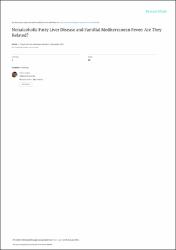| dc.contributor.author | Şarkış, Cihat | |
| dc.contributor.author | Cağlar, Erkan | |
| dc.contributor.author | Uğurlu, Serdal | |
| dc.contributor.author | Çetinkaya, Emel | |
| dc.contributor.author | Tekin, Nilüfer | |
| dc.contributor.author | Arslan, Mübeccel | |
| dc.contributor.author | Özdemir, Sebati | |
| dc.contributor.author | Tuncer, Murat | |
| dc.date.accessioned | 2019-10-17T11:47:03Z | |
| dc.date.available | 2019-10-17T11:47:03Z | |
| dc.date.issued | 2012 | en_US |
| dc.identifier.issn | 0370-8179 | |
| dc.identifier.uri | https://doi.org/10.2298/SARH1210589S | |
| dc.identifier.uri | https://hdl.handle.net/20.500.12462/8744 | |
| dc.description | Şarkış, Cihat (Balikesir Author) | en_US |
| dc.description.abstract | Introduction Familial Mediterranean fever (FMF) is a periodic febrile disease characterized by acute recurrent episodes of serositis. Liver disease is not considered a part of the spectrum of clinical manifestations of FMF.
Objective The purpose of this study was to characterize the nonalcoholic fatty liver disease (NAFLD) that could be associated with familial Mediterranean fever (FMF).
Methods Clinical findings and treatment information of the patients with FMF were obtained from outpatient files. Weight, height, hip and waist circumference, blood pressure, blood C-reactive protein (CRP), erythrocyte sedimentation rate (ESR), fibrinogen, glucose, low-density lipoprotein (LDL), high-density lipoprotein (HDL), triglycerides (TG), creatinine, alanine aminotransferase (ALT), and insulin levels were determined in all subjects, and additionally liver ultrasonography was performed for signs of hepatosteatosis.
Results Fifty-two age and gender matched patients with FMF, and 30 healthy controls were included in the study. The prevalence of metabolic syndrome in the patient group was determined to be significantly higher in the patient group compared to the healthy group. When FMF patients with and without hepatosteatosis were compared, the prevalence of metabolic syndrome was determined to be 6 vs. 3, respectively (p<0.001). Eleven patients with FMF were found to have grade 1-2 hepatosteatosis, and only 6 of healthy subjects had grade 1 hepatoseatosis (p=0.901).
Conclusion When compared with healthy controls, we found the prevalence of NAFLD was not increased in patients with FMF. | en_US |
| dc.language.iso | eng | en_US |
| dc.publisher | Srpsko Lekarsko Drustvo | en_US |
| dc.relation.isversionof | 10.2298/SARH1210589S | en_US |
| dc.rights | info:eu-repo/semantics/openAccess | en_US |
| dc.subject | Familial Mediterranean Fever | en_US |
| dc.subject | Nonalcoholic Fatty Liver Diseases | en_US |
| dc.subject | Metabolic Syndrome | en_US |
| dc.title | Nonalcoholic fatty liver disease and familial mediterranean fever: Are they related? | en_US |
| dc.type | article | en_US |
| dc.relation.journal | Srpski Arhiv Za Celokupno Lekarstvo | en_US |
| dc.contributor.department | Tıp Fakültesi | en_US |
| dc.identifier.volume | 140 | en_US |
| dc.identifier.issue | 9-10 | en_US |
| dc.identifier.startpage | 589 | en_US |
| dc.identifier.endpage | 594 | en_US |
| dc.relation.publicationcategory | Makale - Uluslararası Hakemli Dergi - Kurum Öğretim Elemanı | en_US |


















